Taxation Law of Australia Individual Assignment LAWS20060
VerifiedAdded on 2023/01/18
|12
|3720
|85
Homework Assignment
AI Summary
This document presents a comprehensive solution to a Taxation Law assignment, addressing various aspects of Australian taxation. The assignment covers key topics such as depreciating assets, tax offsets, and marginal tax rates. It delves into specific sections of the Income Tax Assessment Act 1997 (ITAA 1997), including Division 17, s. 118-52, s. 104-15, and s. 4-10(3). The solution analyzes relevant case law, including FC of T v Day 2008 ATC 20-064, focusing on the deductibility of legal expenses. Furthermore, the assignment explores consumption taxes and their impact on consumer behavior. The solution provides practical examples of general deductions under s. 8-1 ITAA 1997, and discusses the tax treatment of various expenses, including loan interest, mobile phone charges, childcare costs, stolen business items, and election-related expenditures. The assignment also analyzes CGT events, including the granting of leases, options, and the sale of shares, and determines the applicability of the discount method. Finally, it examines the taxability of prize money and the difference between allowances and reimbursements for employee business expenses.
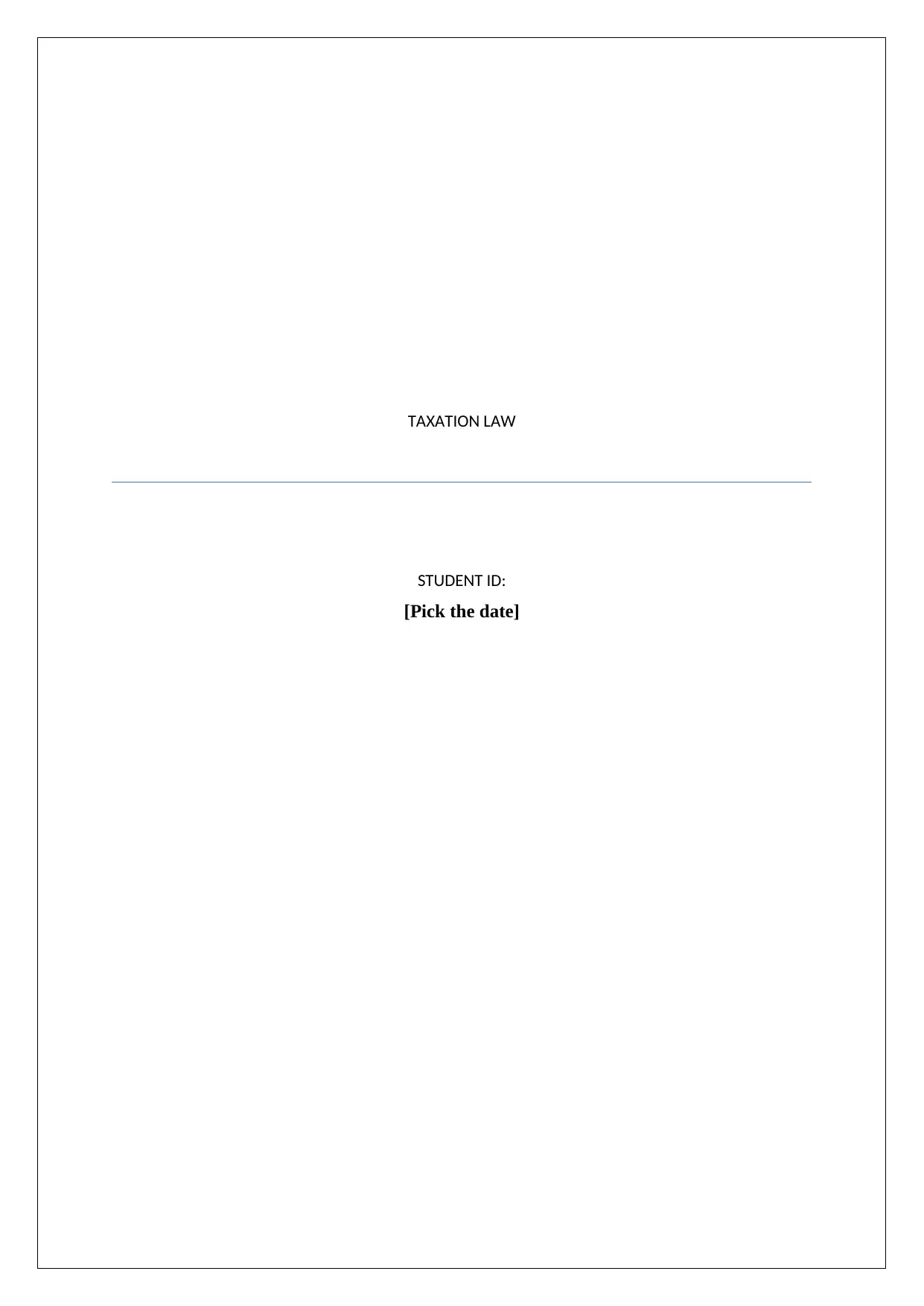
TAXATION LAW
STUDENT ID:
[Pick the date]
STUDENT ID:
[Pick the date]
Paraphrase This Document
Need a fresh take? Get an instant paraphrase of this document with our AI Paraphraser
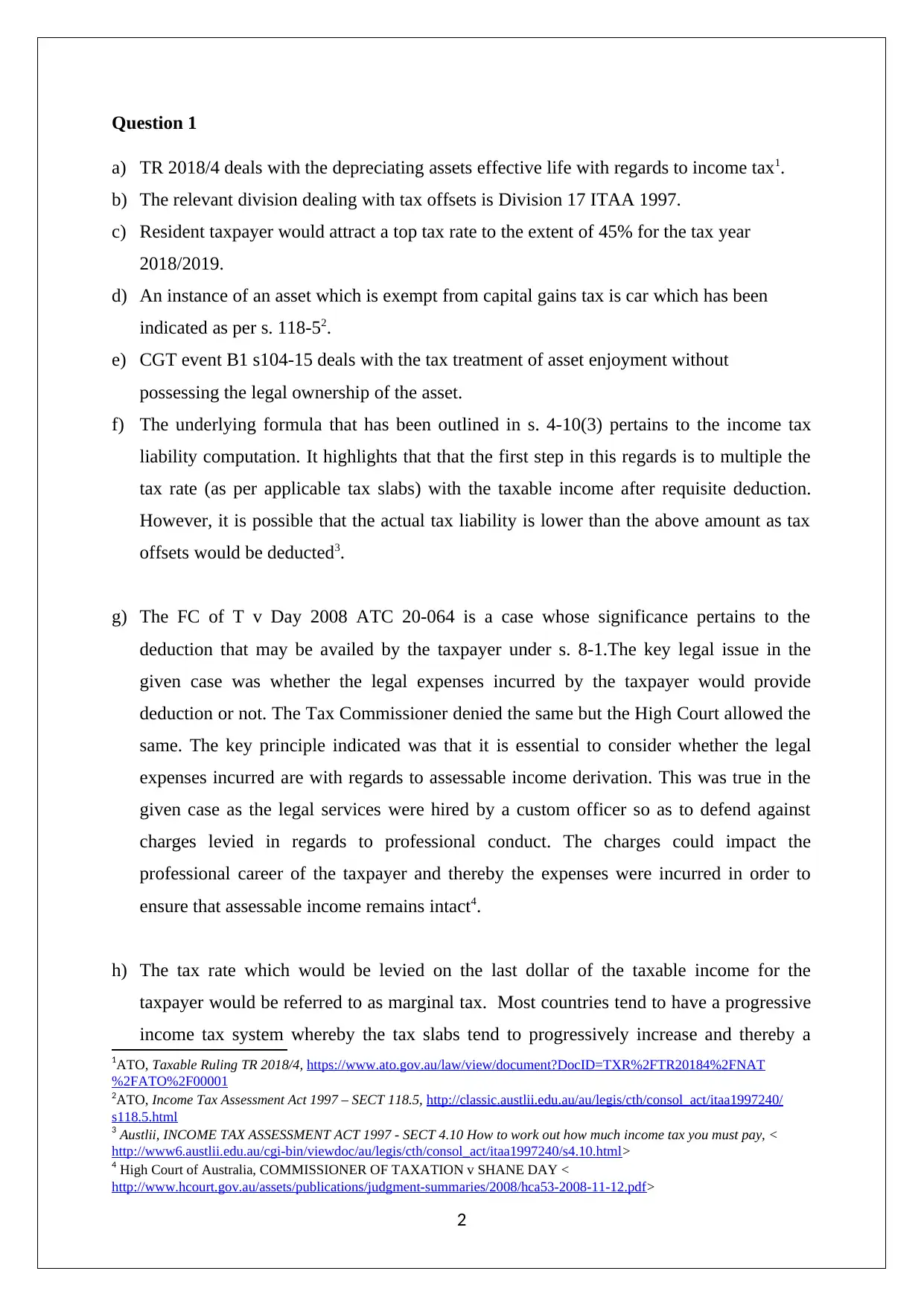
Question 1
a) TR 2018/4 deals with the depreciating assets effective life with regards to income tax1.
b) The relevant division dealing with tax offsets is Division 17 ITAA 1997.
c) Resident taxpayer would attract a top tax rate to the extent of 45% for the tax year
2018/2019.
d) An instance of an asset which is exempt from capital gains tax is car which has been
indicated as per s. 118-52.
e) CGT event B1 s104-15 deals with the tax treatment of asset enjoyment without
possessing the legal ownership of the asset.
f) The underlying formula that has been outlined in s. 4-10(3) pertains to the income tax
liability computation. It highlights that that the first step in this regards is to multiple the
tax rate (as per applicable tax slabs) with the taxable income after requisite deduction.
However, it is possible that the actual tax liability is lower than the above amount as tax
offsets would be deducted3.
g) The FC of T v Day 2008 ATC 20-064 is a case whose significance pertains to the
deduction that may be availed by the taxpayer under s. 8-1.The key legal issue in the
given case was whether the legal expenses incurred by the taxpayer would provide
deduction or not. The Tax Commissioner denied the same but the High Court allowed the
same. The key principle indicated was that it is essential to consider whether the legal
expenses incurred are with regards to assessable income derivation. This was true in the
given case as the legal services were hired by a custom officer so as to defend against
charges levied in regards to professional conduct. The charges could impact the
professional career of the taxpayer and thereby the expenses were incurred in order to
ensure that assessable income remains intact4.
h) The tax rate which would be levied on the last dollar of the taxable income for the
taxpayer would be referred to as marginal tax. Most countries tend to have a progressive
income tax system whereby the tax slabs tend to progressively increase and thereby a
1ATO, Taxable Ruling TR 2018/4, https://www.ato.gov.au/law/view/document?DocID=TXR%2FTR20184%2FNAT
%2FATO%2F00001
2ATO, Income Tax Assessment Act 1997 – SECT 118.5, http://classic.austlii.edu.au/au/legis/cth/consol_act/itaa1997240/
s118.5.html
3 Austlii, INCOME TAX ASSESSMENT ACT 1997 - SECT 4.10 How to work out how much income tax you must pay, <
http://www6.austlii.edu.au/cgi-bin/viewdoc/au/legis/cth/consol_act/itaa1997240/s4.10.html>
4 High Court of Australia, COMMISSIONER OF TAXATION v SHANE DAY <
http://www.hcourt.gov.au/assets/publications/judgment-summaries/2008/hca53-2008-11-12.pdf>
2
a) TR 2018/4 deals with the depreciating assets effective life with regards to income tax1.
b) The relevant division dealing with tax offsets is Division 17 ITAA 1997.
c) Resident taxpayer would attract a top tax rate to the extent of 45% for the tax year
2018/2019.
d) An instance of an asset which is exempt from capital gains tax is car which has been
indicated as per s. 118-52.
e) CGT event B1 s104-15 deals with the tax treatment of asset enjoyment without
possessing the legal ownership of the asset.
f) The underlying formula that has been outlined in s. 4-10(3) pertains to the income tax
liability computation. It highlights that that the first step in this regards is to multiple the
tax rate (as per applicable tax slabs) with the taxable income after requisite deduction.
However, it is possible that the actual tax liability is lower than the above amount as tax
offsets would be deducted3.
g) The FC of T v Day 2008 ATC 20-064 is a case whose significance pertains to the
deduction that may be availed by the taxpayer under s. 8-1.The key legal issue in the
given case was whether the legal expenses incurred by the taxpayer would provide
deduction or not. The Tax Commissioner denied the same but the High Court allowed the
same. The key principle indicated was that it is essential to consider whether the legal
expenses incurred are with regards to assessable income derivation. This was true in the
given case as the legal services were hired by a custom officer so as to defend against
charges levied in regards to professional conduct. The charges could impact the
professional career of the taxpayer and thereby the expenses were incurred in order to
ensure that assessable income remains intact4.
h) The tax rate which would be levied on the last dollar of the taxable income for the
taxpayer would be referred to as marginal tax. Most countries tend to have a progressive
income tax system whereby the tax slabs tend to progressively increase and thereby a
1ATO, Taxable Ruling TR 2018/4, https://www.ato.gov.au/law/view/document?DocID=TXR%2FTR20184%2FNAT
%2FATO%2F00001
2ATO, Income Tax Assessment Act 1997 – SECT 118.5, http://classic.austlii.edu.au/au/legis/cth/consol_act/itaa1997240/
s118.5.html
3 Austlii, INCOME TAX ASSESSMENT ACT 1997 - SECT 4.10 How to work out how much income tax you must pay, <
http://www6.austlii.edu.au/cgi-bin/viewdoc/au/legis/cth/consol_act/itaa1997240/s4.10.html>
4 High Court of Australia, COMMISSIONER OF TAXATION v SHANE DAY <
http://www.hcourt.gov.au/assets/publications/judgment-summaries/2008/hca53-2008-11-12.pdf>
2
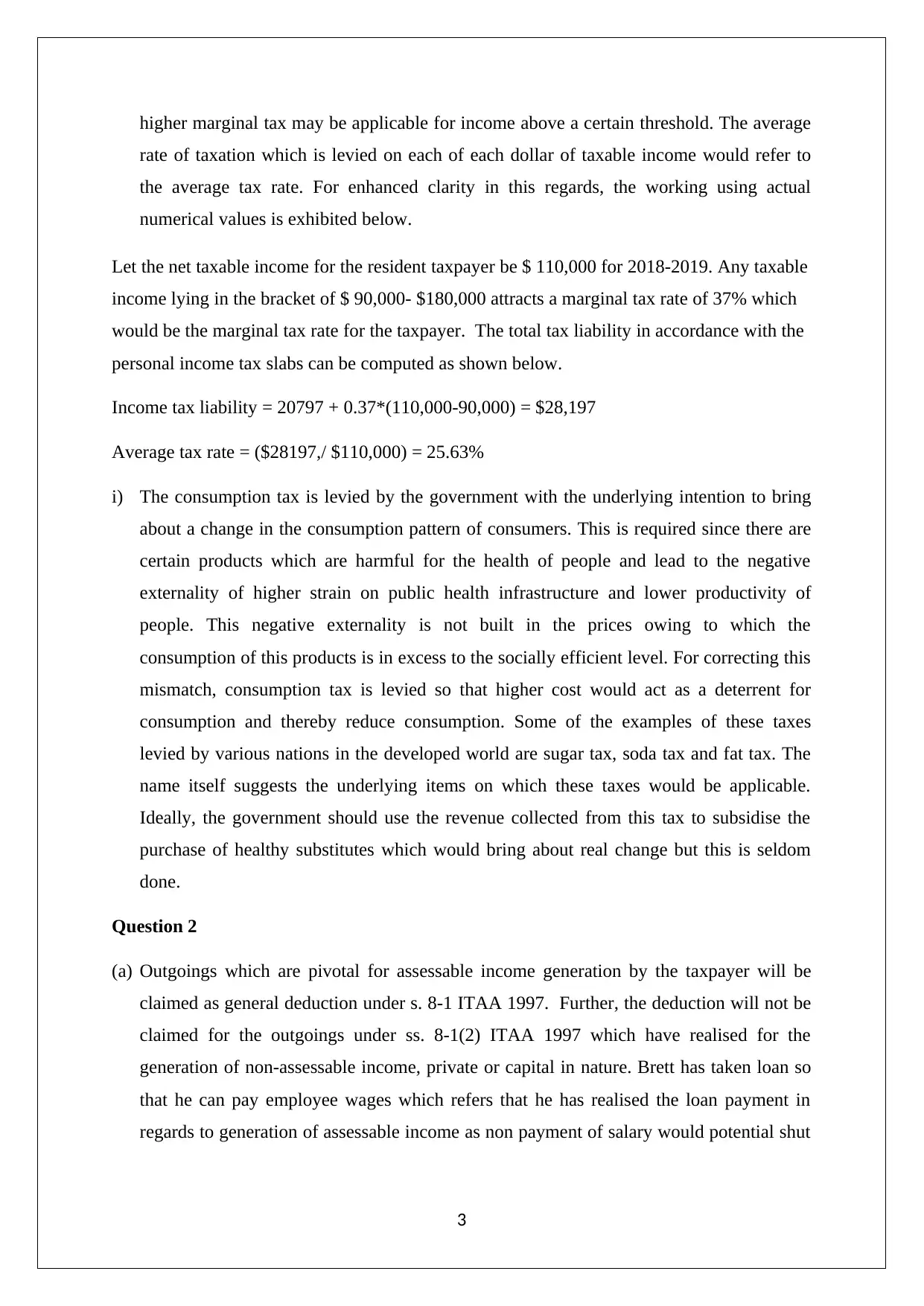
higher marginal tax may be applicable for income above a certain threshold. The average
rate of taxation which is levied on each of each dollar of taxable income would refer to
the average tax rate. For enhanced clarity in this regards, the working using actual
numerical values is exhibited below.
Let the net taxable income for the resident taxpayer be $ 110,000 for 2018-2019. Any taxable
income lying in the bracket of $ 90,000- $180,000 attracts a marginal tax rate of 37% which
would be the marginal tax rate for the taxpayer. The total tax liability in accordance with the
personal income tax slabs can be computed as shown below.
Income tax liability = 20797 + 0.37*(110,000-90,000) = $28,197
Average tax rate = ($28197,/ $110,000) = 25.63%
i) The consumption tax is levied by the government with the underlying intention to bring
about a change in the consumption pattern of consumers. This is required since there are
certain products which are harmful for the health of people and lead to the negative
externality of higher strain on public health infrastructure and lower productivity of
people. This negative externality is not built in the prices owing to which the
consumption of this products is in excess to the socially efficient level. For correcting this
mismatch, consumption tax is levied so that higher cost would act as a deterrent for
consumption and thereby reduce consumption. Some of the examples of these taxes
levied by various nations in the developed world are sugar tax, soda tax and fat tax. The
name itself suggests the underlying items on which these taxes would be applicable.
Ideally, the government should use the revenue collected from this tax to subsidise the
purchase of healthy substitutes which would bring about real change but this is seldom
done.
Question 2
(a) Outgoings which are pivotal for assessable income generation by the taxpayer will be
claimed as general deduction under s. 8-1 ITAA 1997. Further, the deduction will not be
claimed for the outgoings under ss. 8-1(2) ITAA 1997 which have realised for the
generation of non-assessable income, private or capital in nature. Brett has taken loan so
that he can pay employee wages which refers that he has realised the loan payment in
regards to generation of assessable income as non payment of salary would potential shut
3
rate of taxation which is levied on each of each dollar of taxable income would refer to
the average tax rate. For enhanced clarity in this regards, the working using actual
numerical values is exhibited below.
Let the net taxable income for the resident taxpayer be $ 110,000 for 2018-2019. Any taxable
income lying in the bracket of $ 90,000- $180,000 attracts a marginal tax rate of 37% which
would be the marginal tax rate for the taxpayer. The total tax liability in accordance with the
personal income tax slabs can be computed as shown below.
Income tax liability = 20797 + 0.37*(110,000-90,000) = $28,197
Average tax rate = ($28197,/ $110,000) = 25.63%
i) The consumption tax is levied by the government with the underlying intention to bring
about a change in the consumption pattern of consumers. This is required since there are
certain products which are harmful for the health of people and lead to the negative
externality of higher strain on public health infrastructure and lower productivity of
people. This negative externality is not built in the prices owing to which the
consumption of this products is in excess to the socially efficient level. For correcting this
mismatch, consumption tax is levied so that higher cost would act as a deterrent for
consumption and thereby reduce consumption. Some of the examples of these taxes
levied by various nations in the developed world are sugar tax, soda tax and fat tax. The
name itself suggests the underlying items on which these taxes would be applicable.
Ideally, the government should use the revenue collected from this tax to subsidise the
purchase of healthy substitutes which would bring about real change but this is seldom
done.
Question 2
(a) Outgoings which are pivotal for assessable income generation by the taxpayer will be
claimed as general deduction under s. 8-1 ITAA 1997. Further, the deduction will not be
claimed for the outgoings under ss. 8-1(2) ITAA 1997 which have realised for the
generation of non-assessable income, private or capital in nature. Brett has taken loan so
that he can pay employee wages which refers that he has realised the loan payment in
regards to generation of assessable income as non payment of salary would potential shut
3
⊘ This is a preview!⊘
Do you want full access?
Subscribe today to unlock all pages.

Trusted by 1+ million students worldwide
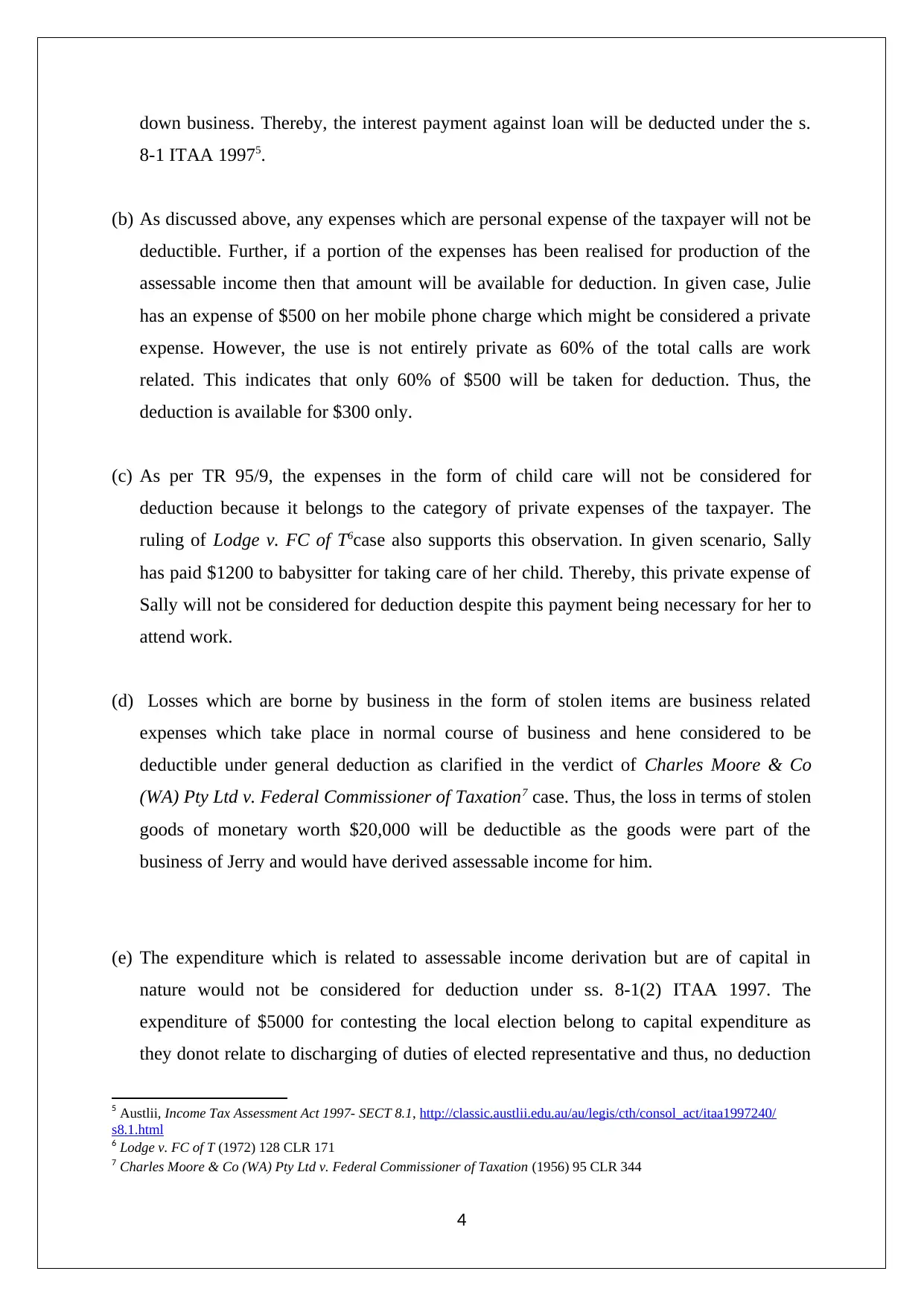
down business. Thereby, the interest payment against loan will be deducted under the s.
8-1 ITAA 19975.
(b) As discussed above, any expenses which are personal expense of the taxpayer will not be
deductible. Further, if a portion of the expenses has been realised for production of the
assessable income then that amount will be available for deduction. In given case, Julie
has an expense of $500 on her mobile phone charge which might be considered a private
expense. However, the use is not entirely private as 60% of the total calls are work
related. This indicates that only 60% of $500 will be taken for deduction. Thus, the
deduction is available for $300 only.
(c) As per TR 95/9, the expenses in the form of child care will not be considered for
deduction because it belongs to the category of private expenses of the taxpayer. The
ruling of Lodge v. FC of T6case also supports this observation. In given scenario, Sally
has paid $1200 to babysitter for taking care of her child. Thereby, this private expense of
Sally will not be considered for deduction despite this payment being necessary for her to
attend work.
(d) Losses which are borne by business in the form of stolen items are business related
expenses which take place in normal course of business and hene considered to be
deductible under general deduction as clarified in the verdict of Charles Moore & Co
(WA) Pty Ltd v. Federal Commissioner of Taxation7 case. Thus, the loss in terms of stolen
goods of monetary worth $20,000 will be deductible as the goods were part of the
business of Jerry and would have derived assessable income for him.
(e) The expenditure which is related to assessable income derivation but are of capital in
nature would not be considered for deduction under ss. 8-1(2) ITAA 1997. The
expenditure of $5000 for contesting the local election belong to capital expenditure as
they donot relate to discharging of duties of elected representative and thus, no deduction
5 Austlii, Income Tax Assessment Act 1997- SECT 8.1, http://classic.austlii.edu.au/au/legis/cth/consol_act/itaa1997240/
s8.1.html
6 Lodge v. FC of T (1972) 128 CLR 171
7 Charles Moore & Co (WA) Pty Ltd v. Federal Commissioner of Taxation (1956) 95 CLR 344
4
8-1 ITAA 19975.
(b) As discussed above, any expenses which are personal expense of the taxpayer will not be
deductible. Further, if a portion of the expenses has been realised for production of the
assessable income then that amount will be available for deduction. In given case, Julie
has an expense of $500 on her mobile phone charge which might be considered a private
expense. However, the use is not entirely private as 60% of the total calls are work
related. This indicates that only 60% of $500 will be taken for deduction. Thus, the
deduction is available for $300 only.
(c) As per TR 95/9, the expenses in the form of child care will not be considered for
deduction because it belongs to the category of private expenses of the taxpayer. The
ruling of Lodge v. FC of T6case also supports this observation. In given scenario, Sally
has paid $1200 to babysitter for taking care of her child. Thereby, this private expense of
Sally will not be considered for deduction despite this payment being necessary for her to
attend work.
(d) Losses which are borne by business in the form of stolen items are business related
expenses which take place in normal course of business and hene considered to be
deductible under general deduction as clarified in the verdict of Charles Moore & Co
(WA) Pty Ltd v. Federal Commissioner of Taxation7 case. Thus, the loss in terms of stolen
goods of monetary worth $20,000 will be deductible as the goods were part of the
business of Jerry and would have derived assessable income for him.
(e) The expenditure which is related to assessable income derivation but are of capital in
nature would not be considered for deduction under ss. 8-1(2) ITAA 1997. The
expenditure of $5000 for contesting the local election belong to capital expenditure as
they donot relate to discharging of duties of elected representative and thus, no deduction
5 Austlii, Income Tax Assessment Act 1997- SECT 8.1, http://classic.austlii.edu.au/au/legis/cth/consol_act/itaa1997240/
s8.1.html
6 Lodge v. FC of T (1972) 128 CLR 171
7 Charles Moore & Co (WA) Pty Ltd v. Federal Commissioner of Taxation (1956) 95 CLR 344
4
Paraphrase This Document
Need a fresh take? Get an instant paraphrase of this document with our AI Paraphraser
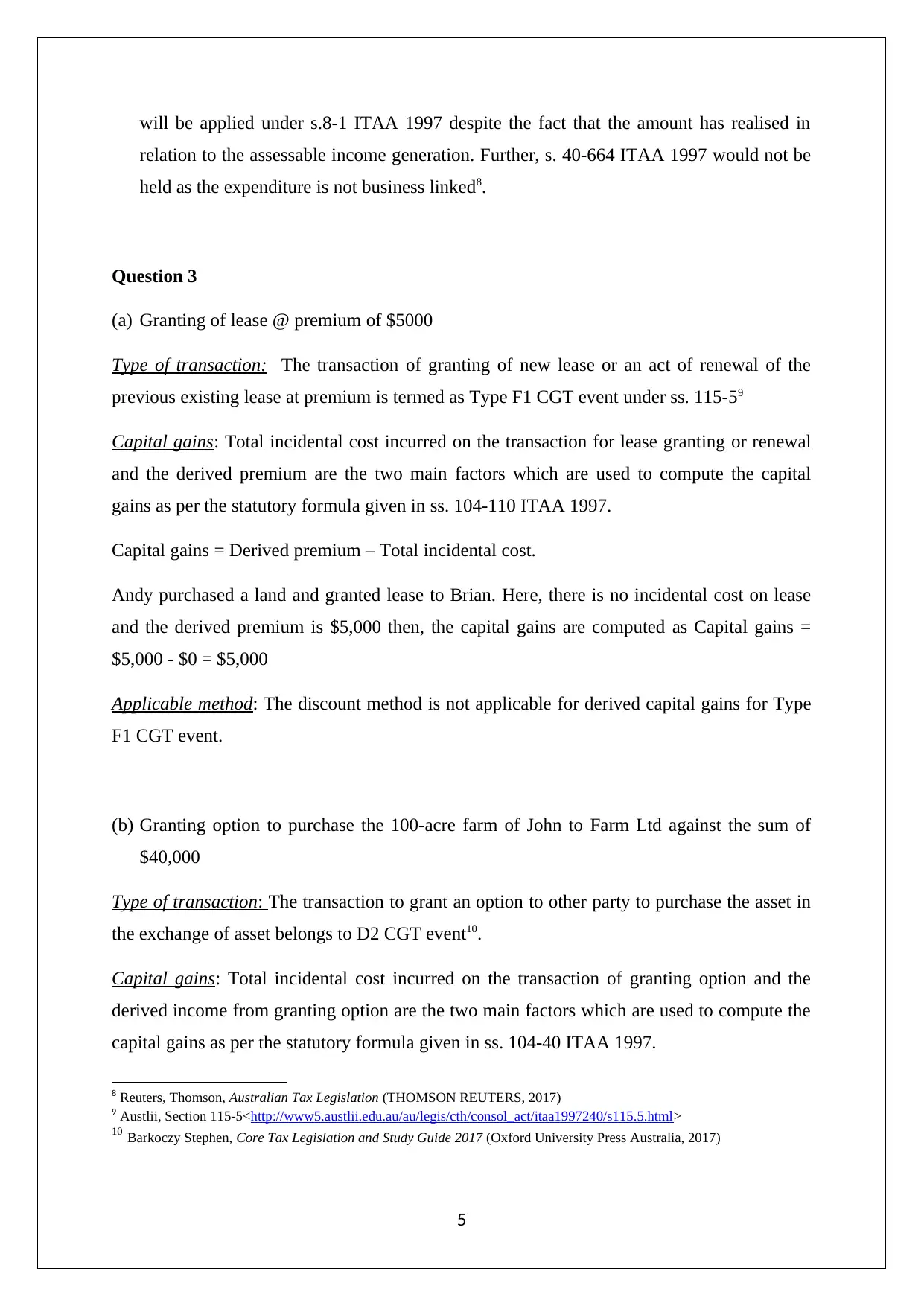
will be applied under s.8-1 ITAA 1997 despite the fact that the amount has realised in
relation to the assessable income generation. Further, s. 40-664 ITAA 1997 would not be
held as the expenditure is not business linked8.
Question 3
(a) Granting of lease @ premium of $5000
Type of transaction: The transaction of granting of new lease or an act of renewal of the
previous existing lease at premium is termed as Type F1 CGT event under ss. 115-59
Capital gains: Total incidental cost incurred on the transaction for lease granting or renewal
and the derived premium are the two main factors which are used to compute the capital
gains as per the statutory formula given in ss. 104-110 ITAA 1997.
Capital gains = Derived premium – Total incidental cost.
Andy purchased a land and granted lease to Brian. Here, there is no incidental cost on lease
and the derived premium is $5,000 then, the capital gains are computed as Capital gains =
$5,000 - $0 = $5,000
Applicable method: The discount method is not applicable for derived capital gains for Type
F1 CGT event.
(b) Granting option to purchase the 100-acre farm of John to Farm Ltd against the sum of
$40,000
Type of transaction: The transaction to grant an option to other party to purchase the asset in
the exchange of asset belongs to D2 CGT event10.
Capital gains: Total incidental cost incurred on the transaction of granting option and the
derived income from granting option are the two main factors which are used to compute the
capital gains as per the statutory formula given in ss. 104-40 ITAA 1997.
8 Reuters, Thomson, Australian Tax Legislation (THOMSON REUTERS, 2017)
9 Austlii, Section 115-5<http://www5.austlii.edu.au/au/legis/cth/consol_act/itaa1997240/s115.5.html>
10 Barkoczy Stephen, Core Tax Legislation and Study Guide 2017 (Oxford University Press Australia, 2017)
5
relation to the assessable income generation. Further, s. 40-664 ITAA 1997 would not be
held as the expenditure is not business linked8.
Question 3
(a) Granting of lease @ premium of $5000
Type of transaction: The transaction of granting of new lease or an act of renewal of the
previous existing lease at premium is termed as Type F1 CGT event under ss. 115-59
Capital gains: Total incidental cost incurred on the transaction for lease granting or renewal
and the derived premium are the two main factors which are used to compute the capital
gains as per the statutory formula given in ss. 104-110 ITAA 1997.
Capital gains = Derived premium – Total incidental cost.
Andy purchased a land and granted lease to Brian. Here, there is no incidental cost on lease
and the derived premium is $5,000 then, the capital gains are computed as Capital gains =
$5,000 - $0 = $5,000
Applicable method: The discount method is not applicable for derived capital gains for Type
F1 CGT event.
(b) Granting option to purchase the 100-acre farm of John to Farm Ltd against the sum of
$40,000
Type of transaction: The transaction to grant an option to other party to purchase the asset in
the exchange of asset belongs to D2 CGT event10.
Capital gains: Total incidental cost incurred on the transaction of granting option and the
derived income from granting option are the two main factors which are used to compute the
capital gains as per the statutory formula given in ss. 104-40 ITAA 1997.
8 Reuters, Thomson, Australian Tax Legislation (THOMSON REUTERS, 2017)
9 Austlii, Section 115-5<http://www5.austlii.edu.au/au/legis/cth/consol_act/itaa1997240/s115.5.html>
10 Barkoczy Stephen, Core Tax Legislation and Study Guide 2017 (Oxford University Press Australia, 2017)
5
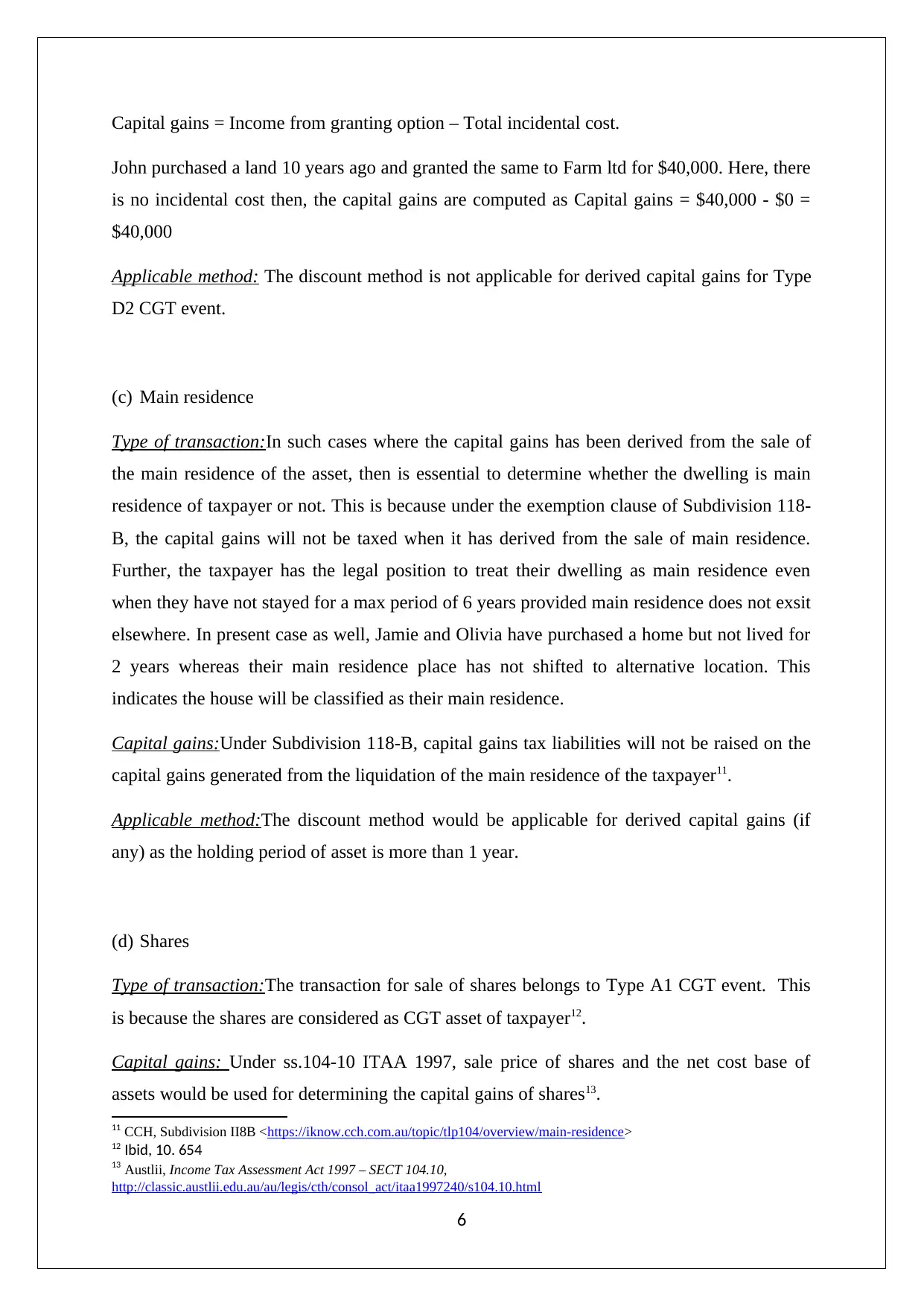
Capital gains = Income from granting option – Total incidental cost.
John purchased a land 10 years ago and granted the same to Farm ltd for $40,000. Here, there
is no incidental cost then, the capital gains are computed as Capital gains = $40,000 - $0 =
$40,000
Applicable method: The discount method is not applicable for derived capital gains for Type
D2 CGT event.
(c) Main residence
Type of transaction:In such cases where the capital gains has been derived from the sale of
the main residence of the asset, then is essential to determine whether the dwelling is main
residence of taxpayer or not. This is because under the exemption clause of Subdivision 118-
B, the capital gains will not be taxed when it has derived from the sale of main residence.
Further, the taxpayer has the legal position to treat their dwelling as main residence even
when they have not stayed for a max period of 6 years provided main residence does not exsit
elsewhere. In present case as well, Jamie and Olivia have purchased a home but not lived for
2 years whereas their main residence place has not shifted to alternative location. This
indicates the house will be classified as their main residence.
Capital gains:Under Subdivision 118-B, capital gains tax liabilities will not be raised on the
capital gains generated from the liquidation of the main residence of the taxpayer11.
Applicable method:The discount method would be applicable for derived capital gains (if
any) as the holding period of asset is more than 1 year.
(d) Shares
Type of transaction:The transaction for sale of shares belongs to Type A1 CGT event. This
is because the shares are considered as CGT asset of taxpayer12.
Capital gains: Under ss.104-10 ITAA 1997, sale price of shares and the net cost base of
assets would be used for determining the capital gains of shares13.
11 CCH, Subdivision II8B <https://iknow.cch.com.au/topic/tlp104/overview/main-residence>
12 Ibid, 10. 654
13 Austlii, Income Tax Assessment Act 1997 – SECT 104.10,
http://classic.austlii.edu.au/au/legis/cth/consol_act/itaa1997240/s104.10.html
6
John purchased a land 10 years ago and granted the same to Farm ltd for $40,000. Here, there
is no incidental cost then, the capital gains are computed as Capital gains = $40,000 - $0 =
$40,000
Applicable method: The discount method is not applicable for derived capital gains for Type
D2 CGT event.
(c) Main residence
Type of transaction:In such cases where the capital gains has been derived from the sale of
the main residence of the asset, then is essential to determine whether the dwelling is main
residence of taxpayer or not. This is because under the exemption clause of Subdivision 118-
B, the capital gains will not be taxed when it has derived from the sale of main residence.
Further, the taxpayer has the legal position to treat their dwelling as main residence even
when they have not stayed for a max period of 6 years provided main residence does not exsit
elsewhere. In present case as well, Jamie and Olivia have purchased a home but not lived for
2 years whereas their main residence place has not shifted to alternative location. This
indicates the house will be classified as their main residence.
Capital gains:Under Subdivision 118-B, capital gains tax liabilities will not be raised on the
capital gains generated from the liquidation of the main residence of the taxpayer11.
Applicable method:The discount method would be applicable for derived capital gains (if
any) as the holding period of asset is more than 1 year.
(d) Shares
Type of transaction:The transaction for sale of shares belongs to Type A1 CGT event. This
is because the shares are considered as CGT asset of taxpayer12.
Capital gains: Under ss.104-10 ITAA 1997, sale price of shares and the net cost base of
assets would be used for determining the capital gains of shares13.
11 CCH, Subdivision II8B <https://iknow.cch.com.au/topic/tlp104/overview/main-residence>
12 Ibid, 10. 654
13 Austlii, Income Tax Assessment Act 1997 – SECT 104.10,
http://classic.austlii.edu.au/au/legis/cth/consol_act/itaa1997240/s104.10.html
6
⊘ This is a preview!⊘
Do you want full access?
Subscribe today to unlock all pages.

Trusted by 1+ million students worldwide
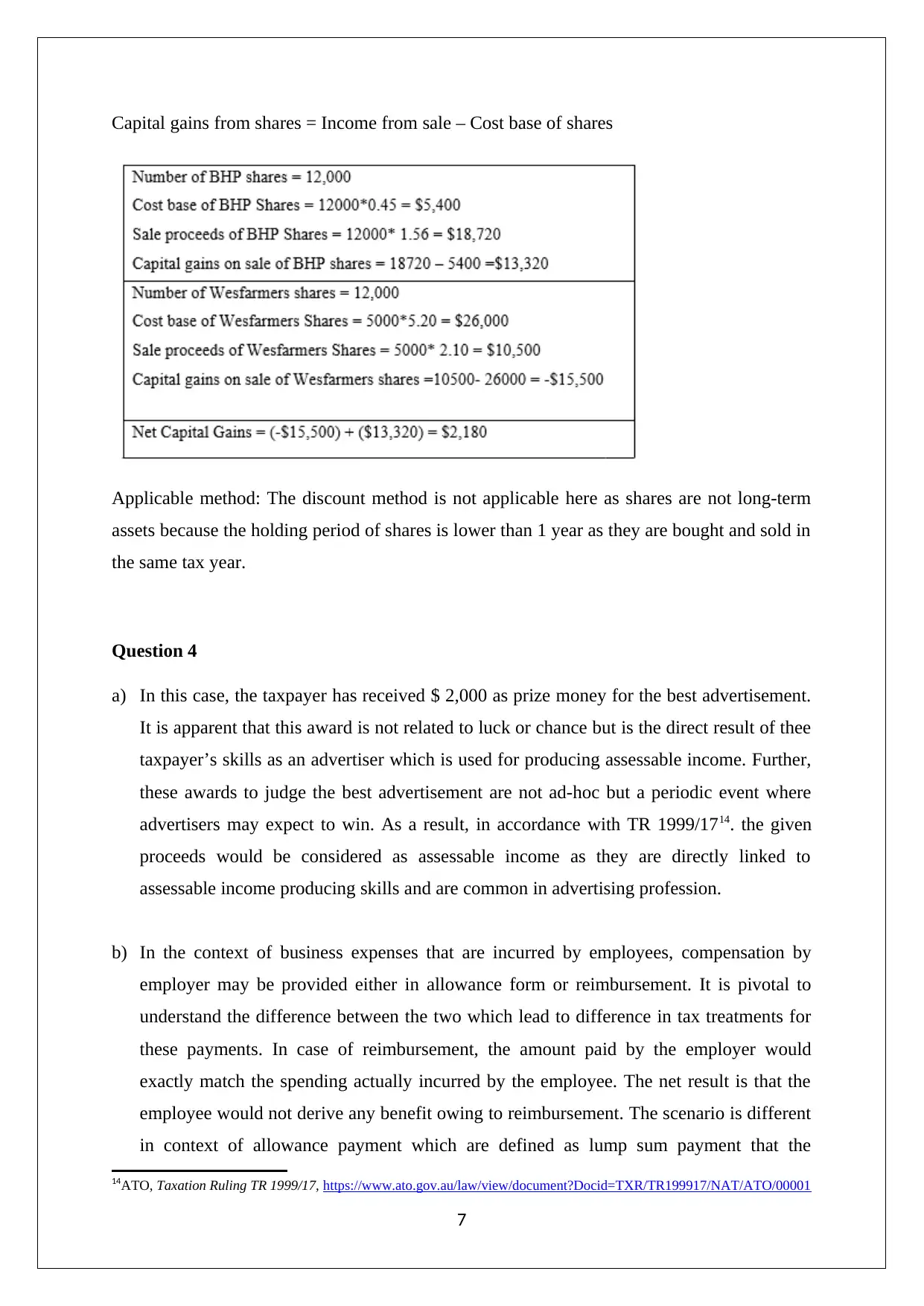
Capital gains from shares = Income from sale – Cost base of shares
Applicable method: The discount method is not applicable here as shares are not long-term
assets because the holding period of shares is lower than 1 year as they are bought and sold in
the same tax year.
Question 4
a) In this case, the taxpayer has received $ 2,000 as prize money for the best advertisement.
It is apparent that this award is not related to luck or chance but is the direct result of thee
taxpayer’s skills as an advertiser which is used for producing assessable income. Further,
these awards to judge the best advertisement are not ad-hoc but a periodic event where
advertisers may expect to win. As a result, in accordance with TR 1999/1714. the given
proceeds would be considered as assessable income as they are directly linked to
assessable income producing skills and are common in advertising profession.
b) In the context of business expenses that are incurred by employees, compensation by
employer may be provided either in allowance form or reimbursement. It is pivotal to
understand the difference between the two which lead to difference in tax treatments for
these payments. In case of reimbursement, the amount paid by the employer would
exactly match the spending actually incurred by the employee. The net result is that the
employee would not derive any benefit owing to reimbursement. The scenario is different
in context of allowance payment which are defined as lump sum payment that the
14ATO, Taxation Ruling TR 1999/17, https://www.ato.gov.au/law/view/document?Docid=TXR/TR199917/NAT/ATO/00001
7
Applicable method: The discount method is not applicable here as shares are not long-term
assets because the holding period of shares is lower than 1 year as they are bought and sold in
the same tax year.
Question 4
a) In this case, the taxpayer has received $ 2,000 as prize money for the best advertisement.
It is apparent that this award is not related to luck or chance but is the direct result of thee
taxpayer’s skills as an advertiser which is used for producing assessable income. Further,
these awards to judge the best advertisement are not ad-hoc but a periodic event where
advertisers may expect to win. As a result, in accordance with TR 1999/1714. the given
proceeds would be considered as assessable income as they are directly linked to
assessable income producing skills and are common in advertising profession.
b) In the context of business expenses that are incurred by employees, compensation by
employer may be provided either in allowance form or reimbursement. It is pivotal to
understand the difference between the two which lead to difference in tax treatments for
these payments. In case of reimbursement, the amount paid by the employer would
exactly match the spending actually incurred by the employee. The net result is that the
employee would not derive any benefit owing to reimbursement. The scenario is different
in context of allowance payment which are defined as lump sum payment that the
14ATO, Taxation Ruling TR 1999/17, https://www.ato.gov.au/law/view/document?Docid=TXR/TR199917/NAT/ATO/00001
7
Paraphrase This Document
Need a fresh take? Get an instant paraphrase of this document with our AI Paraphraser
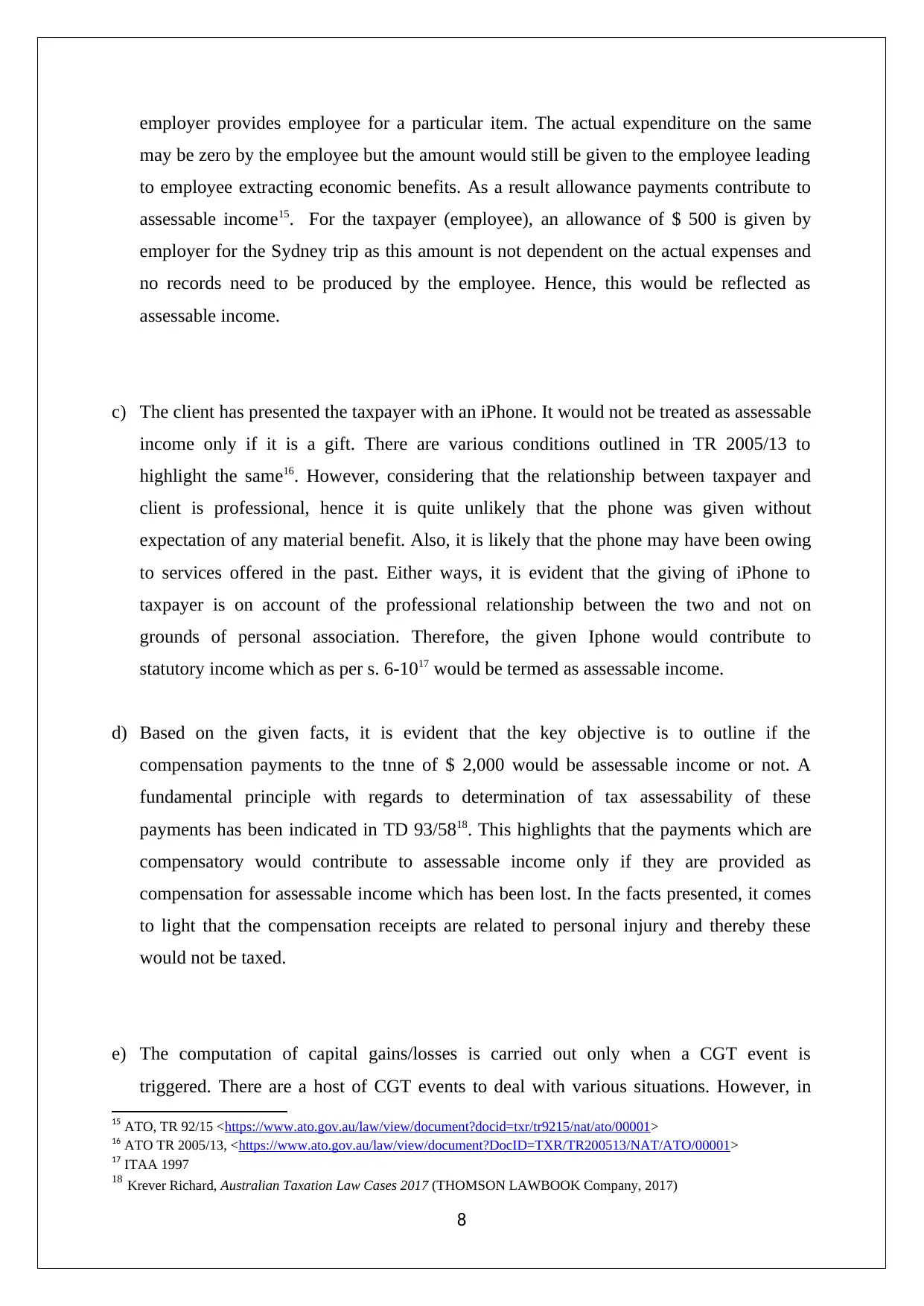
employer provides employee for a particular item. The actual expenditure on the same
may be zero by the employee but the amount would still be given to the employee leading
to employee extracting economic benefits. As a result allowance payments contribute to
assessable income15. For the taxpayer (employee), an allowance of $ 500 is given by
employer for the Sydney trip as this amount is not dependent on the actual expenses and
no records need to be produced by the employee. Hence, this would be reflected as
assessable income.
c) The client has presented the taxpayer with an iPhone. It would not be treated as assessable
income only if it is a gift. There are various conditions outlined in TR 2005/13 to
highlight the same16. However, considering that the relationship between taxpayer and
client is professional, hence it is quite unlikely that the phone was given without
expectation of any material benefit. Also, it is likely that the phone may have been owing
to services offered in the past. Either ways, it is evident that the giving of iPhone to
taxpayer is on account of the professional relationship between the two and not on
grounds of personal association. Therefore, the given Iphone would contribute to
statutory income which as per s. 6-1017 would be termed as assessable income.
d) Based on the given facts, it is evident that the key objective is to outline if the
compensation payments to the tnne of $ 2,000 would be assessable income or not. A
fundamental principle with regards to determination of tax assessability of these
payments has been indicated in TD 93/5818. This highlights that the payments which are
compensatory would contribute to assessable income only if they are provided as
compensation for assessable income which has been lost. In the facts presented, it comes
to light that the compensation receipts are related to personal injury and thereby these
would not be taxed.
e) The computation of capital gains/losses is carried out only when a CGT event is
triggered. There are a host of CGT events to deal with various situations. However, in
15 ATO, TR 92/15 <https://www.ato.gov.au/law/view/document?docid=txr/tr9215/nat/ato/00001>
16 ATO TR 2005/13, <https://www.ato.gov.au/law/view/document?DocID=TXR/TR200513/NAT/ATO/00001>
17 ITAA 1997
18 Krever Richard, Australian Taxation Law Cases 2017 (THOMSON LAWBOOK Company, 2017)
8
may be zero by the employee but the amount would still be given to the employee leading
to employee extracting economic benefits. As a result allowance payments contribute to
assessable income15. For the taxpayer (employee), an allowance of $ 500 is given by
employer for the Sydney trip as this amount is not dependent on the actual expenses and
no records need to be produced by the employee. Hence, this would be reflected as
assessable income.
c) The client has presented the taxpayer with an iPhone. It would not be treated as assessable
income only if it is a gift. There are various conditions outlined in TR 2005/13 to
highlight the same16. However, considering that the relationship between taxpayer and
client is professional, hence it is quite unlikely that the phone was given without
expectation of any material benefit. Also, it is likely that the phone may have been owing
to services offered in the past. Either ways, it is evident that the giving of iPhone to
taxpayer is on account of the professional relationship between the two and not on
grounds of personal association. Therefore, the given Iphone would contribute to
statutory income which as per s. 6-1017 would be termed as assessable income.
d) Based on the given facts, it is evident that the key objective is to outline if the
compensation payments to the tnne of $ 2,000 would be assessable income or not. A
fundamental principle with regards to determination of tax assessability of these
payments has been indicated in TD 93/5818. This highlights that the payments which are
compensatory would contribute to assessable income only if they are provided as
compensation for assessable income which has been lost. In the facts presented, it comes
to light that the compensation receipts are related to personal injury and thereby these
would not be taxed.
e) The computation of capital gains/losses is carried out only when a CGT event is
triggered. There are a host of CGT events to deal with various situations. However, in
15 ATO, TR 92/15 <https://www.ato.gov.au/law/view/document?docid=txr/tr9215/nat/ato/00001>
16 ATO TR 2005/13, <https://www.ato.gov.au/law/view/document?DocID=TXR/TR200513/NAT/ATO/00001>
17 ITAA 1997
18 Krever Richard, Australian Taxation Law Cases 2017 (THOMSON LAWBOOK Company, 2017)
8
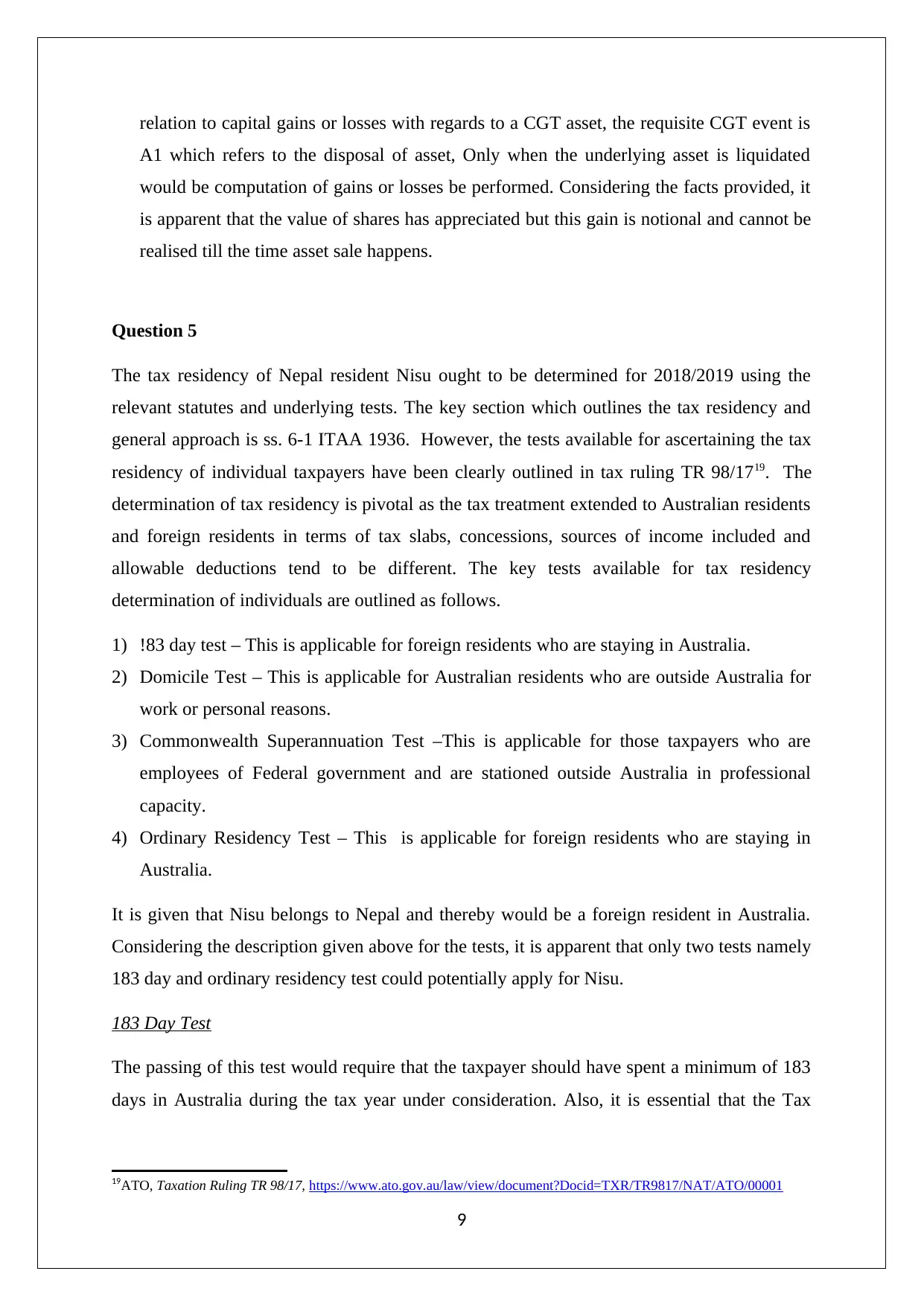
relation to capital gains or losses with regards to a CGT asset, the requisite CGT event is
A1 which refers to the disposal of asset, Only when the underlying asset is liquidated
would be computation of gains or losses be performed. Considering the facts provided, it
is apparent that the value of shares has appreciated but this gain is notional and cannot be
realised till the time asset sale happens.
Question 5
The tax residency of Nepal resident Nisu ought to be determined for 2018/2019 using the
relevant statutes and underlying tests. The key section which outlines the tax residency and
general approach is ss. 6-1 ITAA 1936. However, the tests available for ascertaining the tax
residency of individual taxpayers have been clearly outlined in tax ruling TR 98/1719. The
determination of tax residency is pivotal as the tax treatment extended to Australian residents
and foreign residents in terms of tax slabs, concessions, sources of income included and
allowable deductions tend to be different. The key tests available for tax residency
determination of individuals are outlined as follows.
1) !83 day test – This is applicable for foreign residents who are staying in Australia.
2) Domicile Test – This is applicable for Australian residents who are outside Australia for
work or personal reasons.
3) Commonwealth Superannuation Test –This is applicable for those taxpayers who are
employees of Federal government and are stationed outside Australia in professional
capacity.
4) Ordinary Residency Test – This is applicable for foreign residents who are staying in
Australia.
It is given that Nisu belongs to Nepal and thereby would be a foreign resident in Australia.
Considering the description given above for the tests, it is apparent that only two tests namely
183 day and ordinary residency test could potentially apply for Nisu.
183 Day Test
The passing of this test would require that the taxpayer should have spent a minimum of 183
days in Australia during the tax year under consideration. Also, it is essential that the Tax
19ATO, Taxation Ruling TR 98/17, https://www.ato.gov.au/law/view/document?Docid=TXR/TR9817/NAT/ATO/00001
9
A1 which refers to the disposal of asset, Only when the underlying asset is liquidated
would be computation of gains or losses be performed. Considering the facts provided, it
is apparent that the value of shares has appreciated but this gain is notional and cannot be
realised till the time asset sale happens.
Question 5
The tax residency of Nepal resident Nisu ought to be determined for 2018/2019 using the
relevant statutes and underlying tests. The key section which outlines the tax residency and
general approach is ss. 6-1 ITAA 1936. However, the tests available for ascertaining the tax
residency of individual taxpayers have been clearly outlined in tax ruling TR 98/1719. The
determination of tax residency is pivotal as the tax treatment extended to Australian residents
and foreign residents in terms of tax slabs, concessions, sources of income included and
allowable deductions tend to be different. The key tests available for tax residency
determination of individuals are outlined as follows.
1) !83 day test – This is applicable for foreign residents who are staying in Australia.
2) Domicile Test – This is applicable for Australian residents who are outside Australia for
work or personal reasons.
3) Commonwealth Superannuation Test –This is applicable for those taxpayers who are
employees of Federal government and are stationed outside Australia in professional
capacity.
4) Ordinary Residency Test – This is applicable for foreign residents who are staying in
Australia.
It is given that Nisu belongs to Nepal and thereby would be a foreign resident in Australia.
Considering the description given above for the tests, it is apparent that only two tests namely
183 day and ordinary residency test could potentially apply for Nisu.
183 Day Test
The passing of this test would require that the taxpayer should have spent a minimum of 183
days in Australia during the tax year under consideration. Also, it is essential that the Tax
19ATO, Taxation Ruling TR 98/17, https://www.ato.gov.au/law/view/document?Docid=TXR/TR9817/NAT/ATO/00001
9
⊘ This is a preview!⊘
Do you want full access?
Subscribe today to unlock all pages.

Trusted by 1+ million students worldwide
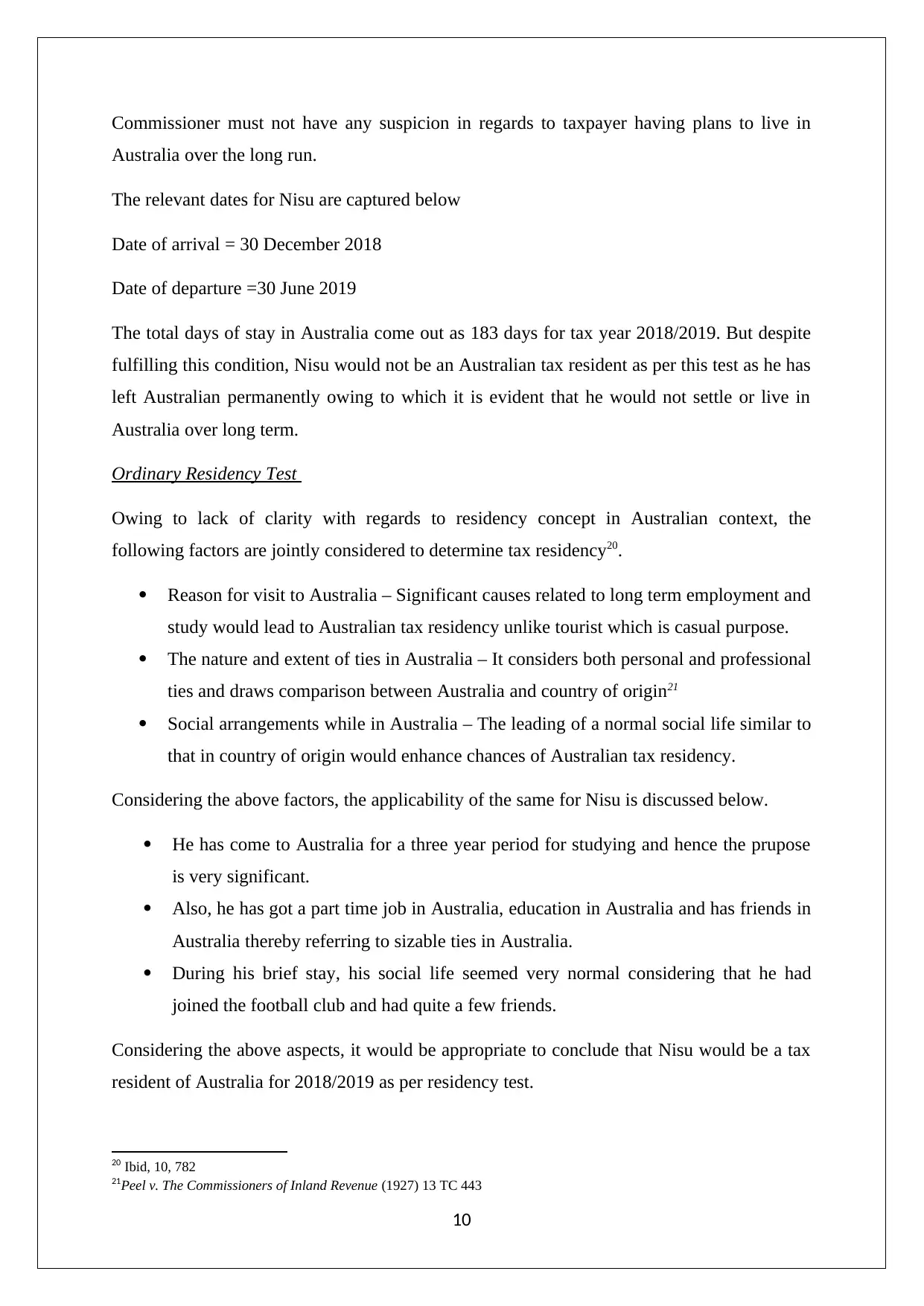
Commissioner must not have any suspicion in regards to taxpayer having plans to live in
Australia over the long run.
The relevant dates for Nisu are captured below
Date of arrival = 30 December 2018
Date of departure =30 June 2019
The total days of stay in Australia come out as 183 days for tax year 2018/2019. But despite
fulfilling this condition, Nisu would not be an Australian tax resident as per this test as he has
left Australian permanently owing to which it is evident that he would not settle or live in
Australia over long term.
Ordinary Residency Test
Owing to lack of clarity with regards to residency concept in Australian context, the
following factors are jointly considered to determine tax residency20.
Reason for visit to Australia – Significant causes related to long term employment and
study would lead to Australian tax residency unlike tourist which is casual purpose.
The nature and extent of ties in Australia – It considers both personal and professional
ties and draws comparison between Australia and country of origin21
Social arrangements while in Australia – The leading of a normal social life similar to
that in country of origin would enhance chances of Australian tax residency.
Considering the above factors, the applicability of the same for Nisu is discussed below.
He has come to Australia for a three year period for studying and hence the prupose
is very significant.
Also, he has got a part time job in Australia, education in Australia and has friends in
Australia thereby referring to sizable ties in Australia.
During his brief stay, his social life seemed very normal considering that he had
joined the football club and had quite a few friends.
Considering the above aspects, it would be appropriate to conclude that Nisu would be a tax
resident of Australia for 2018/2019 as per residency test.
20 Ibid, 10, 782
21Peel v. The Commissioners of Inland Revenue (1927) 13 TC 443
10
Australia over the long run.
The relevant dates for Nisu are captured below
Date of arrival = 30 December 2018
Date of departure =30 June 2019
The total days of stay in Australia come out as 183 days for tax year 2018/2019. But despite
fulfilling this condition, Nisu would not be an Australian tax resident as per this test as he has
left Australian permanently owing to which it is evident that he would not settle or live in
Australia over long term.
Ordinary Residency Test
Owing to lack of clarity with regards to residency concept in Australian context, the
following factors are jointly considered to determine tax residency20.
Reason for visit to Australia – Significant causes related to long term employment and
study would lead to Australian tax residency unlike tourist which is casual purpose.
The nature and extent of ties in Australia – It considers both personal and professional
ties and draws comparison between Australia and country of origin21
Social arrangements while in Australia – The leading of a normal social life similar to
that in country of origin would enhance chances of Australian tax residency.
Considering the above factors, the applicability of the same for Nisu is discussed below.
He has come to Australia for a three year period for studying and hence the prupose
is very significant.
Also, he has got a part time job in Australia, education in Australia and has friends in
Australia thereby referring to sizable ties in Australia.
During his brief stay, his social life seemed very normal considering that he had
joined the football club and had quite a few friends.
Considering the above aspects, it would be appropriate to conclude that Nisu would be a tax
resident of Australia for 2018/2019 as per residency test.
20 Ibid, 10, 782
21Peel v. The Commissioners of Inland Revenue (1927) 13 TC 443
10
Paraphrase This Document
Need a fresh take? Get an instant paraphrase of this document with our AI Paraphraser
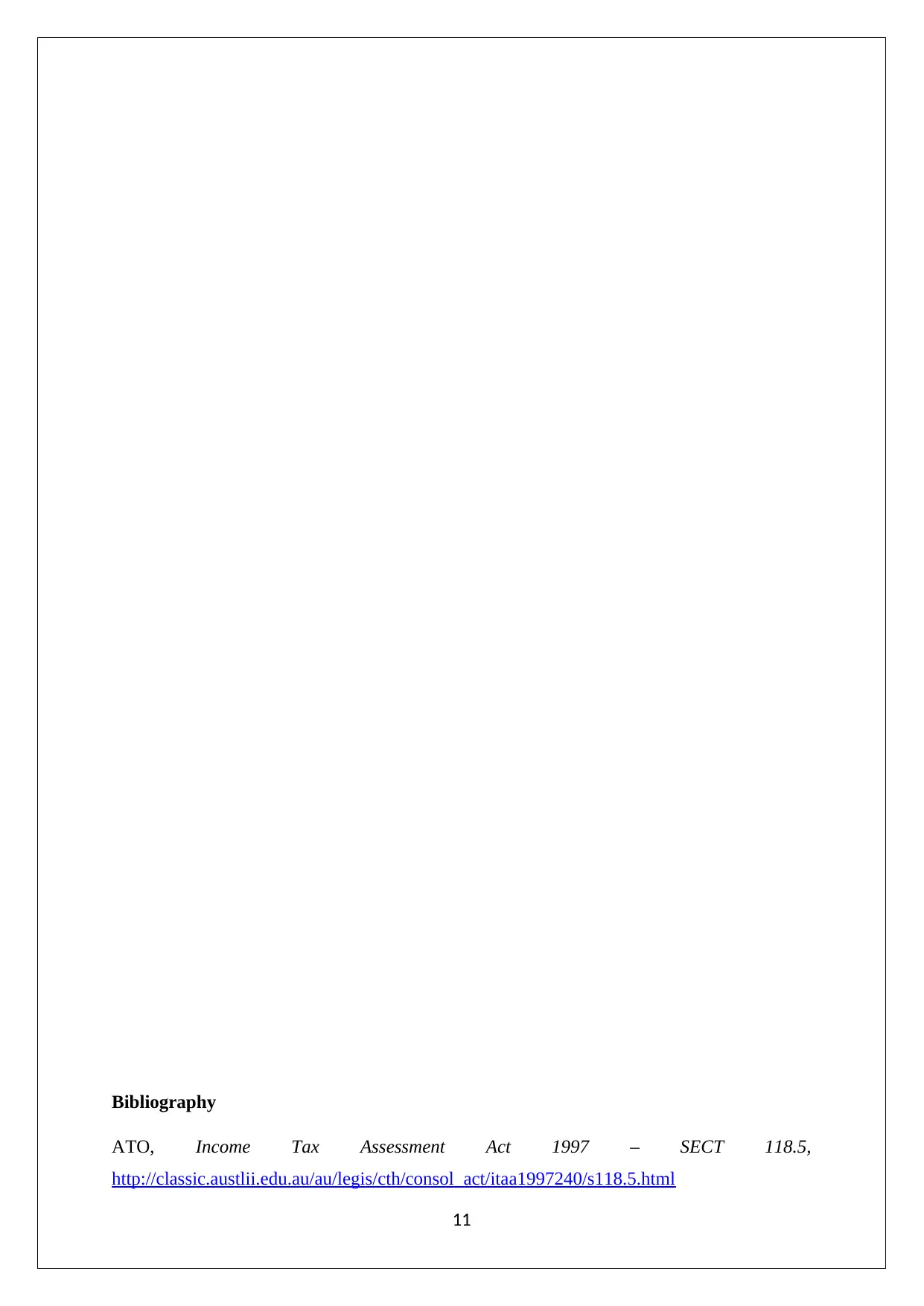
Bibliography
ATO, Income Tax Assessment Act 1997 – SECT 118.5,
http://classic.austlii.edu.au/au/legis/cth/consol_act/itaa1997240/s118.5.html
11
ATO, Income Tax Assessment Act 1997 – SECT 118.5,
http://classic.austlii.edu.au/au/legis/cth/consol_act/itaa1997240/s118.5.html
11
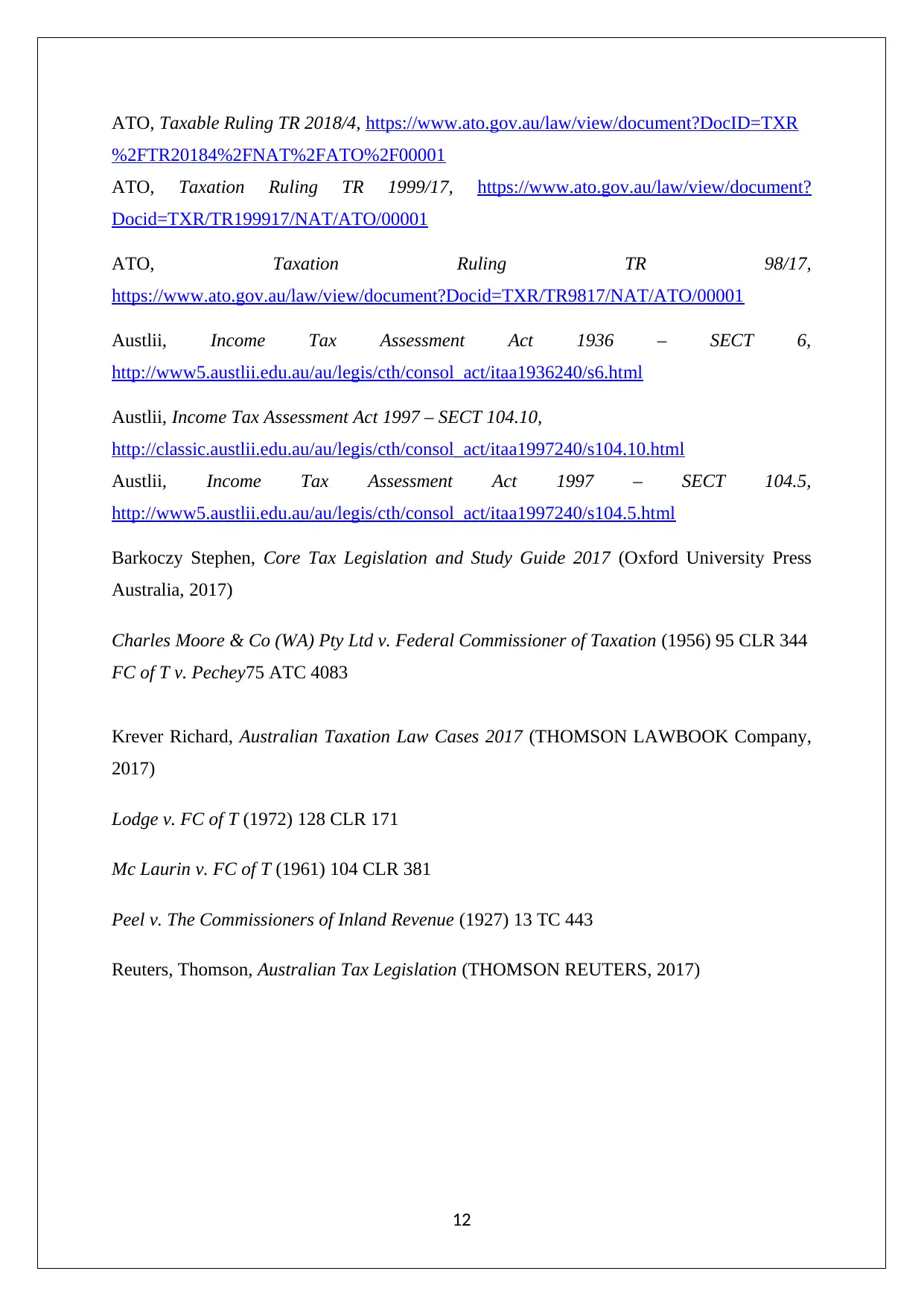
ATO, Taxable Ruling TR 2018/4, https://www.ato.gov.au/law/view/document?DocID=TXR
%2FTR20184%2FNAT%2FATO%2F00001
ATO, Taxation Ruling TR 1999/17, https://www.ato.gov.au/law/view/document?
Docid=TXR/TR199917/NAT/ATO/00001
ATO, Taxation Ruling TR 98/17,
https://www.ato.gov.au/law/view/document?Docid=TXR/TR9817/NAT/ATO/00001
Austlii, Income Tax Assessment Act 1936 – SECT 6,
http://www5.austlii.edu.au/au/legis/cth/consol_act/itaa1936240/s6.html
Austlii, Income Tax Assessment Act 1997 – SECT 104.10,
http://classic.austlii.edu.au/au/legis/cth/consol_act/itaa1997240/s104.10.html
Austlii, Income Tax Assessment Act 1997 – SECT 104.5,
http://www5.austlii.edu.au/au/legis/cth/consol_act/itaa1997240/s104.5.html
Barkoczy Stephen, Core Tax Legislation and Study Guide 2017 (Oxford University Press
Australia, 2017)
Charles Moore & Co (WA) Pty Ltd v. Federal Commissioner of Taxation (1956) 95 CLR 344
FC of T v. Pechey75 ATC 4083
Krever Richard, Australian Taxation Law Cases 2017 (THOMSON LAWBOOK Company,
2017)
Lodge v. FC of T (1972) 128 CLR 171
Mc Laurin v. FC of T (1961) 104 CLR 381
Peel v. The Commissioners of Inland Revenue (1927) 13 TC 443
Reuters, Thomson, Australian Tax Legislation (THOMSON REUTERS, 2017)
12
%2FTR20184%2FNAT%2FATO%2F00001
ATO, Taxation Ruling TR 1999/17, https://www.ato.gov.au/law/view/document?
Docid=TXR/TR199917/NAT/ATO/00001
ATO, Taxation Ruling TR 98/17,
https://www.ato.gov.au/law/view/document?Docid=TXR/TR9817/NAT/ATO/00001
Austlii, Income Tax Assessment Act 1936 – SECT 6,
http://www5.austlii.edu.au/au/legis/cth/consol_act/itaa1936240/s6.html
Austlii, Income Tax Assessment Act 1997 – SECT 104.10,
http://classic.austlii.edu.au/au/legis/cth/consol_act/itaa1997240/s104.10.html
Austlii, Income Tax Assessment Act 1997 – SECT 104.5,
http://www5.austlii.edu.au/au/legis/cth/consol_act/itaa1997240/s104.5.html
Barkoczy Stephen, Core Tax Legislation and Study Guide 2017 (Oxford University Press
Australia, 2017)
Charles Moore & Co (WA) Pty Ltd v. Federal Commissioner of Taxation (1956) 95 CLR 344
FC of T v. Pechey75 ATC 4083
Krever Richard, Australian Taxation Law Cases 2017 (THOMSON LAWBOOK Company,
2017)
Lodge v. FC of T (1972) 128 CLR 171
Mc Laurin v. FC of T (1961) 104 CLR 381
Peel v. The Commissioners of Inland Revenue (1927) 13 TC 443
Reuters, Thomson, Australian Tax Legislation (THOMSON REUTERS, 2017)
12
⊘ This is a preview!⊘
Do you want full access?
Subscribe today to unlock all pages.

Trusted by 1+ million students worldwide
1 out of 12
Related Documents
Your All-in-One AI-Powered Toolkit for Academic Success.
+13062052269
info@desklib.com
Available 24*7 on WhatsApp / Email
![[object Object]](/_next/static/media/star-bottom.7253800d.svg)
Unlock your academic potential
Copyright © 2020–2025 A2Z Services. All Rights Reserved. Developed and managed by ZUCOL.





